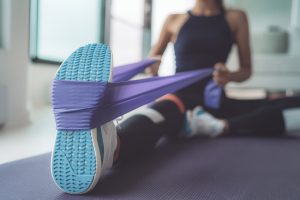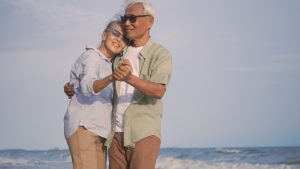
*This is an article from the Summer 2022 issue of Contentment Magazine.
By Jeff Jernigan, PhD, BCPPC, FAIS
My appearance can be deceiving. What most people see when I walk into the room is an average looking old guy. What they do not see is one leg is shorter than the other, height is a couple of inches shorter than it was thirty years ago, and the left knee is blown out. Running for any reason, let alone exercise, is out of the question and walking was an iffy thing back in the day as well. Living with disability after half a lifetime of outdoor activities, competitive sports, and no physical restrictions created another set of emotional limitations. The great discovery during those years was realizing movement was my salvation.
Being a disabled veteran does not mean anyone has to live a disabled life. Recovery took a long time during which aspirin and ice became my best friends. The best advice given came from a rehab physiologist who made the simple statement, “Movement will be your salvation.” It was a life lesson moment! They went on to describe how movement; increasing our metabolism, preserving our flexibility, stretching muscles, pumping oxygen, and improving posture is good for our physical and mental health. If we make intentional movement a part of our life, it will preserve our life.
When we move our metabolism carries nutrients created by the food we eat to the brain where it nourishes our neural pathways and replenishes the neurotransmitters which enable the different structures in our brain to communicate effectively with one another. Exercise which includes raising our metabolism for a sustained period of time as well as including interludes of intense motion creates an enzyme which triggers a process of repair and replacement of damaged neural pathways and brain cells while we sleep. Movement, motion, and exercise are healing in their effect.
Getting up from our chairs at the table or desk to stretch and walk around for a moment allows oxygen to reach muscles cramped by our sitting position. Walking outside to look down the street or take in the sky or standing at a window looking at the long view rests your eyes relieving strain. When this includes taking slow deep breathes, the low-grade stress built up by an eighteen-inch stare at a computer screen evaporates. If your home or office includes stairs, take a moment to take a flight or two up and down. A normal pace will help align your hips and relieve your lower back, which will also relieve the stress produced by the almost unnoticeable pain poor posture and lack of movement while you work creates.
The key to resilience is making these things a habit so we don’t fall back into unintentional self-injury due to bad habits. Accompanied by good diet, exercise, and sleep, your resilience will build steadily. Too much alcohol and fast foods that introduce toxins into our bodies can sabotage our efforts to build good habits as well. Here are some of the practices that have sustained me over the years, all of which include motion.
My wife, Nancy, and I have a goal of 10,000 steps a day. For us, this is a combination of many things: work, errands, and time around the house are the usual source of steps. But for many of us these are the only source of steps in our daily routine. Several times a week Nancy will take me and the dog for a walk. On weekends we always try to include a 5K walk. For us this is a 120 steps per minute pace, or about three miles per hour. You can also pace yourself based on taking approximately twenty minutes to walk one mile. Occasionally we will play tennis with friends, go hiking or rock climbing.
We use an exercise band which has some elasticity to stretch at our desks in sitting and standing positions focused on the upper body. This is also handy when traveling. Some people prefer to use a mat for exercise which allows more freedom of movement alternately exercising the upper and lower body. We tried this with our daughter once. Standing looking at the mats, Nancy said, “Well, let’s lay down and do our sitting up exercises.” Our daughter responded with, “How about we just lay down?” Not everyone favors this method, but everyone can find a method that works for them. Some people are runners, some people like to use a gym, and others have their own exercise equipment at home. If you don’t use it, you lose it: resilience, that is.

Resistance band exercise at home.
The other related life lesson came from my clinical supervisor many years ago. He was talking about physical recovery as much as he was talking about counseling recovery using a favorite phrase, “You have to face the pain if you want to get better.” The pain for many when it comes to movement, especially exercise, includes unwillingness to give up something in order to build a new habit. Or the need to lose some weight that is impacting health. The lack of someone to do these things with can drag down our motivation. Our stubborn and often compulsive drive to work, work, work can get in the way of a healthy work/life balance. Lack of meaningful relationships and even inability to find purpose in our work can be an anchor when it comes to self-care as well. There are many, many reasons for not joining the movement. Movement which all circle back to some dimension of our unwillingness to face the pain.
Two things trap us into an, “Uhhh huh, no thanks” response when it comes to doing hard things. One is the tyranny of the urgent. We get in the habit of allowing the urgent facing us to dictate our priorities without realizing there is always a choice. We don’t plan for interruptions in our day, nor do we set aside time for our own nourishment. As a result, busyness replaces productivity as we get sidetracked by the urgent which is not necessarily the expedient. Stop, take a deep breath, and ask yourself, “Do I really need to do this now?”
The second trap we set for ourselves is the expediency bias which is a follow-on to tyranny of the urgent. The expediency bias shows up when we go with doing the thing that seems right, though it seldom is when “expedient” is just another word for compulsive. Going with our gut is almost an unconscious thing and can be a subconscious reason for justifying giving in to our first impulse. Stop, take a deep breath, and ask yourself, “Do I really need to do this now?”

Our brain processes existing habits much more easily than new ones, which is why stopping to think about what comes next when faced with something that seems natural and practical (expedient) is necessary to overcoming the urgent. We are wired to favor things that work or make us feel good and away from uncomfortable things. Move toward more motion in your life, let movement be your salvation. That remark first heard years ago, “Movement will be your salvation,” was the key not only to physical recovery but to ongoing resilience and health throughout the following decades.
ABOUT THE AUTHOR

Jeff Jernigan is a board-certified mental health professional known for influencing change in people and organizations by capitalizing on growth and change through leadership selection and development. Jeff currently serves Stanton Chase Pacific as the regional Life-Science and Healthcare Practice Leader for retained executive search and is the national subject matter expert for psychometric and psychological client support services.
A lifetime focus on humanitarian service is reflected in Jeff’s role as the Chief Executive Officer and co-founder, with his wife Nancy, for the Hidden Value Group, an organization bringing healing, health, and hope to the world in the wake of mass disaster and violence through healthcare, education, and leadership development. They have completed more than 300 projects in 25 countries over the last 27 years. Jeff currently serves as a Subject Matter Expert, Master Teacher, Research Mentor, or Fellow in the following professional organizations: American Association of Suicidology, National Association for Addiction Professionals, The American Institute of Stress, International Association for Continuing Education and Training, American College of Healthcare Executives and the Wellness Council of America.
Contentment Magazine
The dictionary defines “content” as being in a state of peaceful happiness. The AIS magazine is called Contentment because we want all of our guests and members to find contentment in their lives by learning about stress management and finding what works best for each them. Stress is unavoidable, and comes in many shapes and sizes that makes being in a state of peaceful happiness seem like a very lofty goal. But happiness is easy to find once you are able to find ways to manage your stress and keep a healthy perspective when going though difficult times in life. You will always have stress, but stress does not always have you!

Leave A Comment
You must be logged in to post a comment.